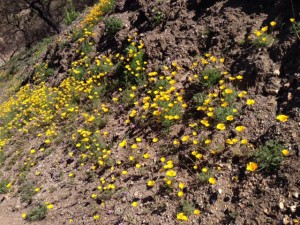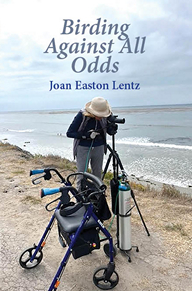Today I went hiking with my sister, Ellen. We visited a favorite trail, the Aliso Loop, located at Sage Hill Campground reached by Paradise Road north of Santa Barbara.
We got on the trail early, for it was to be a hot day.
Aliso Canyon burned in the White Fire of 2013. Today was a great lesson in what comes back first after a chaparral fire–the plants that are “fire followers”.
The canyon was in shadow when we began. As we gained elevation and hit the shaley slopes, the sun warmed us. The pretty bright yellow Tufted Poppies (Eschscholzia caespitosa) clung to the steep hillsides.
I sought the true fire followers, those plants that require the scarification of their seeds by heat or fire in order to thrive. They’re profuse right after a burn. By the third or fourth year after a fire, the fire followers tend to drop off, and other plants take their place.
The Gambel’s Phacelia (Phacelia viscida var. albiflora) is a small-flowered white phacelia that’s rather unique to our region. Local botanist Larry Ballard says he’s never observed this form anywhere else. Just imagine William Gambel collecting the type specimen here in Santa Barbara in 1842.
Delicate Mariposa Lilies (Calochortus catalinae) grew in loose colonies or spread their white, tulip-shaped blooms among other flowers.
Above all, I looked for Whispering Bells (Emmenanthe penduliflora). The pale yellow bell-shaped flowers will eventually die and their dried husks supposedly make a papery tinkling sound when the wind blows. In what has got to be one of the most unique experiments of all time, botanists discovered in 1977 that the seeds of Whispering Bells will only germinate if exposed to chemicals found in smoke or burnt wood.
No wonder they are among the first of the fire followers to sprout after a burn.
Some chaparral shrubs on the trail had begun to stump sprout. Chamise and scrub oak were starting up strong. Other species, such as Ceanothus, will germinate from seed, but they hadn’t done so yet.
And there were birds!
Lazuli Buntings are attracted to post-burn landscapes. They perch up and sing on the charred branches of shrubs, while all around them is an assortment of blooming wildflowers that bring in insects.
I could hear the song of the gorgeous, male Lazuli Bunting, as we hiked along. From the top of a dead branch, his aquamarine and rust colors shone against a patch of yellow mustard.
Another stunning bird on the hike — the Blue Grosbeak–was a pleasant surprise. The male Blue Grosbeak looks dark from a distance, but in good light the bird is a stunning deep blue with buffy wing-bars.
At the top of the ridge, you get a great panorama of the north slopes of the Santa Ynez Mountains covered in dense California Live Oaks. Looking down on what used to be the waterway of the Santa Ynez River, you see only a dry, rocky channel where the water onced flowed.
Enjoying the lush growth of annuals along the trail, you wouldn’t know we’re in a drought; the sight of the river with no water is a grim reminder.
Still, the Aliso Loop hike is a super example of nature’s resilience, and worth seeing in the next week or so before the flowers are gone.




